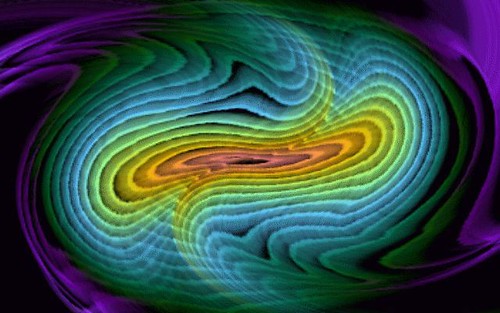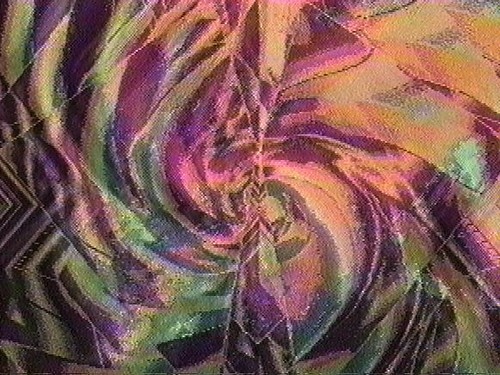Personal computers and noise-reduction software have contributed to a burst of interest in electronic voice phenomena (EVP), a means by which disembodied spirits, presumably the surviving personalities of people who have died, are said to leave voice impressions on tape. The field has even expanded to include visual recordings (hence the whole field is now often called Instrumental Transcommunication, or ITC).

Psychical researchers -- many of them amateurs, in the good original sense of the word, meaning someone who does something for the love of it rather than as a job -- are excited about EVP because it gets around the traditional problems associated with mediumship.
Mediums are not a pure conduit between this world and the next. Their "reception" may be good or less good; furthermore, they seem to filter messages through their own knowledge, assumptions and personalities. So what you hear from a medium may be partly the thoughts of a spirit, partly the interpretation of the medium.
Another, and more serious, drawback to mediumship leads even many believers in the paranormal to question whether their utterances are actually sourced in the dead. Doubt is raised by the possible confounding factor of telepathy. Suppose you are a sitter at a seance and the medium tells you that she is in touch with your brother, who passed on several years ago. Speaking through the medium, your "brother" mentions some names and facts you recognize, and even alludes to some secret that only you and your brother shared.
Is that proof that you are in touch with your brother's spirit? Not if you accept telepathy, which is the most firmly established of all psychic phenomena. The medium could simply be picking up the information from your own mind. Some disbelievers in post-mortem survival, even those who sign off on other kinds of paranormal events, scoff at the idea of talking with the "dead" for that reason.
EVP has several potential advantages over mediumship for serious psychical research. Analyzing voices of putatively non-human origin recorded on tape adds an element of objectivity. No skeptic, as far as I know, has ever claimed that a tape recorder reads minds or imagines that it is hearing something that isn't there.

Naturally, EVP has its critics too, both inside and outside the psychical research community. Since EVP was first publicized by Konstantin Raudive and David Ellis in 1971, it has been claimed that the radio receivers tuned between stations to provide white noise were actually picking up faint radio broadcasts. Second -- a perfectly reasonable prima facie objection --it's claimed that the so-called voices on the recording medium are imaginary. Listeners hear a lot of random sound and mentally convert some of it into voices. It's well established in psychology that the human mind abhors random stimuli and converts them into recognizable patterns, the basis for Rorschach ink-blot tests and the reason why we've all had the experience of mistakenly "hearing" the phone ring above the noise of a shower.
A Scottish researcher, Alexander MacRae, reported in the Journal of the Society for Psychical Research (October 2005 -- sorry, no link available) on an experiment he designed and carried out in the hope of ruling out both these objections. The technical details are too much to go into for a blog posting, but I'll try to cover the highlights.
MacRae took his recording equipment to a specially designed room lent to him for the purpose by the Institute of Noetic Sciences in Petaluma, California. The room is doubly "screened": impervious to sound waves from outside it and to electromagnetic waves, such as radio waves. Thus, anything recorded during the experiment could not come from outside the room -- or, at least, outside the room in the physical dimension. MacRae was the only person in the chamber, and he spoke not a word during the recording. There were no other sound sources such as ticking clocks or creaking chairs.
Apparent voices were indeed recorded. Following the recording session, the sounds were transmitted to a computer as sound files and optimized for clarity: subjected to noise reduction, filtered digitally to emphasize the higher frequencies, bringing all the sound samples up to a standard volume level, and slowing the samples down. All these techniques are designed to overcome a poor signal-to-noise ratio or iron out the sonic oddities typically heard in EVP voices.
The conditions of the recording ruled out the possibility that what was being recorded were stray sounds or radio-frequency transmissions. Next, MacRae set out to determine experimentally whether the recorded "voices" were actually saying recognizable words or were just noise that listeners fashioned into words in their own minds.
The utterances were sent as .wav sound files via e-mail to seven participants, located in different countries, who had no contact with each other. They were asked to listen to them and choose one group of words -- the group that MacRae believed he heard -- out of five groups. The four made-up, or decoy, groups were carefully chosen to have the same number of words, phonemes, rhythm, and stresses as the "real" group.
In the multiple choice test, every one of the seven participants chose the correct alternative more often than not, and in most cases by a wide margin. By constructing a grid with the particpants on the vertical scale and the 10 utterances on the horizontal scale, with notations for either correct or incorrect choices at the intersections, it was possible to calculate the mathematical odds of this particular pattern occurring by chance.
"The odds against this pattern of concurrence among participants being obtained purely by chance are 5 to the 55th power, or about 277 billion, billion, billion, billion to one," MacRae writes. "The results, therefore, tend to indicate that the sounds were an aid to comprehension, that they had a physical, real-world validity, rather than just being subjective, as some would aver." (Calculating the odds of results being down to chance is not black magic; it's a standard practice whose methodology is well established in statistics and experimental scientific research.)
As a further check, the listening panel was sent another five-option test, but this time the sound was just random noise. The "rules of the game" were exactly as before: the participants believed that they were choosing the one correct speech sample.
"The results were slow in coming, and the participants were very apologetic," MacRae writes. "Each one explained that they had tried and tried and they felt that they were letting me down, or showing signs of age, but nobody could make speech out of random noise, in spite of the personal 'pressure' and the expectation of being able to do so."
No single experiment clinches anything -- replication is essential to the scientific method -- but this one certainly suggests that the "sound leakage" and "imposing imaginary patterns" arguments against EVP can't explain every instance.
MacRae's experiment was not designed to prove anything about what makes EVP recordings. Spirits of people who've passed from earthly life? That's a whole different question, and one not likely to be settled soon beyond dispute. For now, those who conduct or are familiar with EVP recordings will have to decide that for themselves.
The American Association of Electronic Voice Phenomena will hold its 2006 conference, "Life After Death: The Evidence" June 8-10 in Atlanta. Alexander MacRae will be among the speakers.
Mediums are not a pure conduit between this world and the next. Their "reception" may be good or less good; furthermore, they seem to filter messages through their own knowledge, assumptions and personalities. So what you hear from a medium may be partly the thoughts of a spirit, partly the interpretation of the medium.
Another, and more serious, drawback to mediumship leads even many believers in the paranormal to question whether their utterances are actually sourced in the dead. Doubt is raised by the possible confounding factor of telepathy. Suppose you are a sitter at a seance and the medium tells you that she is in touch with your brother, who passed on several years ago. Speaking through the medium, your "brother" mentions some names and facts you recognize, and even alludes to some secret that only you and your brother shared.
Is that proof that you are in touch with your brother's spirit? Not if you accept telepathy, which is the most firmly established of all psychic phenomena. The medium could simply be picking up the information from your own mind. Some disbelievers in post-mortem survival, even those who sign off on other kinds of paranormal events, scoff at the idea of talking with the "dead" for that reason.
EVP has several potential advantages over mediumship for serious psychical research. Analyzing voices of putatively non-human origin recorded on tape adds an element of objectivity. No skeptic, as far as I know, has ever claimed that a tape recorder reads minds or imagines that it is hearing something that isn't there.

Of course, people listening to recordings of alleged voices from the beyond can imagine they're hearing things. The voices obtained through EVP are not very clear in raw form. They seem to need a source of noise that they can use to shape sound that resembles a human voice; EVP experimenters usually supply this in the form of "white noise" or some other kind of aural medium. So the communications are usually immersed in a sonic gunk that makes them hard to discern. In addition, the voices caught on tape don't resemble human speech in pitch or rhythm.
Enter computer software. Researchers tidy up the voices through noise reduction, speed manipulation and by boosting certain frequencies (EVP speech is said to be deficient in the higher frequencies compared with living persons' speech). Why are the recorded EVP voices so peculiar? No one has a definitive answer, but the consensus is that spirits do not have material vocal apparatus -- since they don't have bodies -- and therefore they can't talk. They can only create "talk" audible to us through imitating voices, a process akin to us trying to fly using artificial bird wings.
Enter computer software. Researchers tidy up the voices through noise reduction, speed manipulation and by boosting certain frequencies (EVP speech is said to be deficient in the higher frequencies compared with living persons' speech). Why are the recorded EVP voices so peculiar? No one has a definitive answer, but the consensus is that spirits do not have material vocal apparatus -- since they don't have bodies -- and therefore they can't talk. They can only create "talk" audible to us through imitating voices, a process akin to us trying to fly using artificial bird wings.
Naturally, EVP has its critics too, both inside and outside the psychical research community. Since EVP was first publicized by Konstantin Raudive and David Ellis in 1971, it has been claimed that the radio receivers tuned between stations to provide white noise were actually picking up faint radio broadcasts. Second -- a perfectly reasonable prima facie objection --it's claimed that the so-called voices on the recording medium are imaginary. Listeners hear a lot of random sound and mentally convert some of it into voices. It's well established in psychology that the human mind abhors random stimuli and converts them into recognizable patterns, the basis for Rorschach ink-blot tests and the reason why we've all had the experience of mistakenly "hearing" the phone ring above the noise of a shower.
A Scottish researcher, Alexander MacRae, reported in the Journal of the Society for Psychical Research (October 2005 -- sorry, no link available) on an experiment he designed and carried out in the hope of ruling out both these objections. The technical details are too much to go into for a blog posting, but I'll try to cover the highlights.
MacRae took his recording equipment to a specially designed room lent to him for the purpose by the Institute of Noetic Sciences in Petaluma, California. The room is doubly "screened": impervious to sound waves from outside it and to electromagnetic waves, such as radio waves. Thus, anything recorded during the experiment could not come from outside the room -- or, at least, outside the room in the physical dimension. MacRae was the only person in the chamber, and he spoke not a word during the recording. There were no other sound sources such as ticking clocks or creaking chairs.
Apparent voices were indeed recorded. Following the recording session, the sounds were transmitted to a computer as sound files and optimized for clarity: subjected to noise reduction, filtered digitally to emphasize the higher frequencies, bringing all the sound samples up to a standard volume level, and slowing the samples down. All these techniques are designed to overcome a poor signal-to-noise ratio or iron out the sonic oddities typically heard in EVP voices.
The conditions of the recording ruled out the possibility that what was being recorded were stray sounds or radio-frequency transmissions. Next, MacRae set out to determine experimentally whether the recorded "voices" were actually saying recognizable words or were just noise that listeners fashioned into words in their own minds.
The utterances were sent as .wav sound files via e-mail to seven participants, located in different countries, who had no contact with each other. They were asked to listen to them and choose one group of words -- the group that MacRae believed he heard -- out of five groups. The four made-up, or decoy, groups were carefully chosen to have the same number of words, phonemes, rhythm, and stresses as the "real" group.
In the multiple choice test, every one of the seven participants chose the correct alternative more often than not, and in most cases by a wide margin. By constructing a grid with the particpants on the vertical scale and the 10 utterances on the horizontal scale, with notations for either correct or incorrect choices at the intersections, it was possible to calculate the mathematical odds of this particular pattern occurring by chance.
"The odds against this pattern of concurrence among participants being obtained purely by chance are 5 to the 55th power, or about 277 billion, billion, billion, billion to one," MacRae writes. "The results, therefore, tend to indicate that the sounds were an aid to comprehension, that they had a physical, real-world validity, rather than just being subjective, as some would aver." (Calculating the odds of results being down to chance is not black magic; it's a standard practice whose methodology is well established in statistics and experimental scientific research.)
As a further check, the listening panel was sent another five-option test, but this time the sound was just random noise. The "rules of the game" were exactly as before: the participants believed that they were choosing the one correct speech sample.
"The results were slow in coming, and the participants were very apologetic," MacRae writes. "Each one explained that they had tried and tried and they felt that they were letting me down, or showing signs of age, but nobody could make speech out of random noise, in spite of the personal 'pressure' and the expectation of being able to do so."
No single experiment clinches anything -- replication is essential to the scientific method -- but this one certainly suggests that the "sound leakage" and "imposing imaginary patterns" arguments against EVP can't explain every instance.
MacRae's experiment was not designed to prove anything about what makes EVP recordings. Spirits of people who've passed from earthly life? That's a whole different question, and one not likely to be settled soon beyond dispute. For now, those who conduct or are familiar with EVP recordings will have to decide that for themselves.
The American Association of Electronic Voice Phenomena will hold its 2006 conference, "Life After Death: The Evidence" June 8-10 in Atlanta. Alexander MacRae will be among the speakers.



1 comment:
Hmmm, I have to admit that those recordings, assuming they're not fraudulent, are difficult to explain away.
Post a Comment